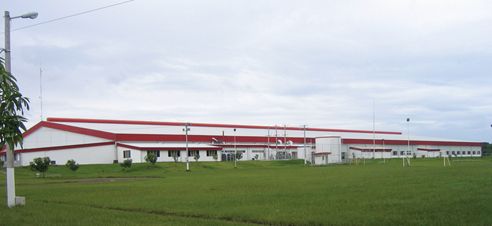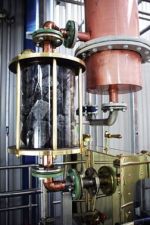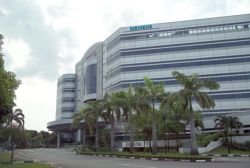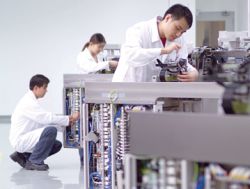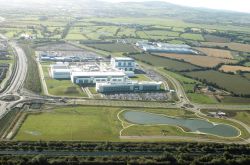
|
|
|
From Site Selection magazine, November 2005
WORLD REPORTS
|
|
|
New Investment Transforms Nicaragua
icaragua, Central America’s largest country, is hoping a new revolution of investment and jobs will sweep away the lingering memories of the 1980s when civil war and the Iran-Contra hearings dominated the news. Today, Nicaragua is pushing itself as a prime spot for manufacturing, tourism and back office services. It is benefiting from proximity to the U.S. market, and the recent passage of CAFTA figures to maintain the country’s recent momentum. Miami-based apparel maker The Argus Group is expanding aggressively in Central America as it hopes to take advantage of CAFTA. “We are doubling the size of our company in the next two years and that growth is going to come almost exclusively out of Nicaragua,” said Robert Bequillard, Argus Group’s president and COO. “The best place in the Americas to set up labor-intensive manufacturing facilities today is Nicaragua. Nicaragua offers a favorable cost structure, and provides the advantage of proximity and access to the U.S. market. It is also a safe and pleasant place in which to do business. Locating our production in Central America has allowed us to shorten our supply cycle times, which is a key competitive advantage for our company.” Argus produces apparel for a variety of major U.S. brands including Van Heusen, Sara Lee, Kellwood, L.L. Bean and Russell Athletic. It manufactures more than 2.6 million garments per week and employs more than 6,000. That employment number figures to grow by 3,000 after Argus completes construction on a 300,000-sq.-ft. (28,000-sq.-m.) jeans-wear plant in Granada, Nicaragua. Called Atlantic Apparel, it will be the company’s fourth apparel factory in the country. Argus also has apparel operations in El Salvador. Another company on the move in Nicaragua is Armecom, a joint venture between Japan’s Yazaki Corporation and Xignux of Mexico. The company has expanded rapidly since it first established operations in Nicaragua in 2002. The manufacturer of cables, instrument panels and wire harness assemblies for U.S. automakers has three production facilities in the country and employs more than 4,000, with plans to expand to 5,000 by 2007.
|
||||
|
Brazilian Projects Rising to Top
Alltech, a Lexington, Ky.-based multinational biotechnology company providing natural solutions to the feed and food industries, is investing $25 million to build the world’s largest yeast facility. The project is a joint venture with a sugar plant company, Val do Ivai in Parana, of Brazil. The fully automated high-tech plant will be capable of providing four times the production capacity of Alltech’s plant in Serbia. Total investment will increase to $40 million by 2007 at the plant, which is surrounded by sugar cane plantations. It is designed to use almost 100 percent of renewable raw materials. The M&G Group is building the world’s largest PET plant near the town of Ipojuca in the State of Pernambucko in northeastern Brazil. It will have a capacity of 990 million lbs/yr. and will come on stream in late 2006. |
||||
|
Project Picks Up Icelandic Spirits
|
||||
|
Singapore Plans to Double
Manufacturing Output
ingapore has no intention of losing ground as a regional manufacturing hub in Southeast Asia to China or anyone else. To the contrary, the government announced in September plans to double manufacturing output to US$177.4 billion and to raise the skill profile of manufacturing workers from 32 percent to 50 percent by 2018. The Singapore Economic Develop-ment Board (EDB) is executing a six-part strategy to make sure this goal is met; it intends to create 15,000 manufacturing jobs from new manufacturing projects and 6,500 additional service-sector jobs annually through 2018. “Manufacturing and services mutually reinforce each other,” noted Lim Swee Say, Minister, Prime Minister’s Office and Second Minister for National Development, at EDB’s Manufacturing Conference in September. “A dynamic manufacturing sector creates demand for a range of services — from logistics and ports to finance and IT. A stronger services sector, in turn, makes Singapore a more conducive location for manufacturing activities, creating a mutually reinforcing growth cycle.”
EDB’s plan includes enhancing supply-chain capabilities, cultivating clusters of suppliers to support key industries, further developing manufacturing skill sets, facilitating trade agreements to provide greater market access, supporting emerging industries (nanotechnology, bio-technology and others) to prompt growth in manufacturing and intensifying R&D to boost overall competitiveness. Singapore already is a leading R&D center in Asia, and the government has committed another $7 billion, or 3 percent of GDP, to supporting that activity through 2010. Plenty of Western companies conduct their research in Singapore, including Dell Computer, Novartis and Welch Allyn. Philips Electronics employs 1,200 engineers in Singapore, and Hewlett-Packard opened its Integrity Server R&D Centre there in June. On the manufacturing side, CIBA Vision opened a contact-lens manufacturing plant in Singapore in May, and Micron Technology expanded its high-speed memory component test and assembly facility, which employs about 3,000 people. Micron is one of several semiconductor companies operating in Singapore; the cluster includes about 300 supplier companies.
|
||||
|
Wyeth’s Dublin Campus Makes Debut
Three facilities — a drug development unit, a drug substance site, and a drug product plant — comprise the campus. They will phase in production over the next four years. Among the products Wyeth will manufacture at Grange Castle is Enbrel, an arthritis treatment for which the company owns the rights outside the U.S. Genzyme is also investing in Europe with expansions in Belgium, Ireland and the United Kingdom. In Belgium, the company is expanding its protein manufacturing capacity in Geel. Expansion in Waterford, Ireland, will make this facility the major European production and distribution center for a broad range of Genzyme products. The latest expansion at Waterford adds a high-quality biological fill/finish center to support the growth of protein and antibody products manufactured at other Genzyme facilities.
Genzyme’s first discovery laboratory outside the U.S., in Cambridge, England, puts the company in proximity to a cluster of nearly 200 biotech firms. It will serve as a center for clinical trial support in Europe. Also, Genzyme’s Haverhill, U.K., plant is undergoing another in a series of expansions. The latest will support clinical development of a wide range of potential new therapies.
|
||||
|
|
||||

©2005 Conway
|
